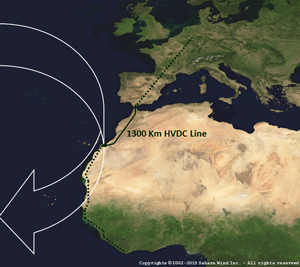 With the available transmission technology today, the prospect of importing renewable electricity from remote and thinly settled regions is economically viable and technically feasible. High Voltage Direct Current transmissions have a high availability and reliability rate, as shown by over 50 years of operation. For large electricity transfers, High Voltage Direct Current technology (HVDC) enables very fast control of power flows, which implies stability improvements not only for the HVDC link but also for the entire surrounding AC systems.
With the available transmission technology today, the prospect of importing renewable electricity from remote and thinly settled regions is economically viable and technically feasible. High Voltage Direct Current transmissions have a high availability and reliability rate, as shown by over 50 years of operation. For large electricity transfers, High Voltage Direct Current technology (HVDC) enables very fast control of power flows, which implies stability improvements not only for the HVDC link but also for the entire surrounding AC systems.
Existing Ultra-High Voltage Direct Current (UHVDC) technology limit large power cumulative line and AC-DC-AC converting losses, to less than 10% over a distance of 3500 km.
Integrating Atlantic trade winds in regional electricity transmission networks will also facilitate their access. By reinforcing African grid networks, the Sahara Wind project’s 5 GW HVDC transmission line enables excess wind energy to be delivered to both Sub-Saharan and European electricity markets. This energy provides a market-based renewable energy alternative essential to support the region’s sustained economic development.
With a phased implementation and a threshold capacity of 400-500 MW submitted to international funding institutions in 2005, the Sahara Wind project initial phases focus on building capacities through industrial synergies. Once deployed on a regional basis, the project’s sheer size enables significant economies of scales to be achieved.
In supporting the diversification of its energy supply through a regionally integrated project development framework based on efficient transformation of mineral resources, climate and energy security prospects can be effectively addressed. As main beneficiaries of this renewable power infrastructure, Africa can further Europe's energy transition most effectively.
| Features |
Base informations | Investment Costs |
| Performance class | 5 GW | |
| Rated voltage | +-500 kV | |
| Type | Double bipol | |
| Converting station | 2 * 60 €/kW | 120 €/kWel. ratedpower |
| Line Distance | 3500 km | |
| Aerial line | 70 €/(kW * 1000 km) | 245 €/kWel. ratedpower |
| Sea cable | 700 €/(kW * 1000 km) | 35 €/kWel. ratedpower |
| Total Investment Cost | 400 €/kWel. ratedpower | |
| Life time | 25 years | |
| Operation & Maintenance Costs | 1% of investment costs/yr | |
| Interest rate | 5% | |
| Transmission losses (average) | 7.5% | |
| Investment Costs of HVDC line from Sahara Desert through Europe | ||



